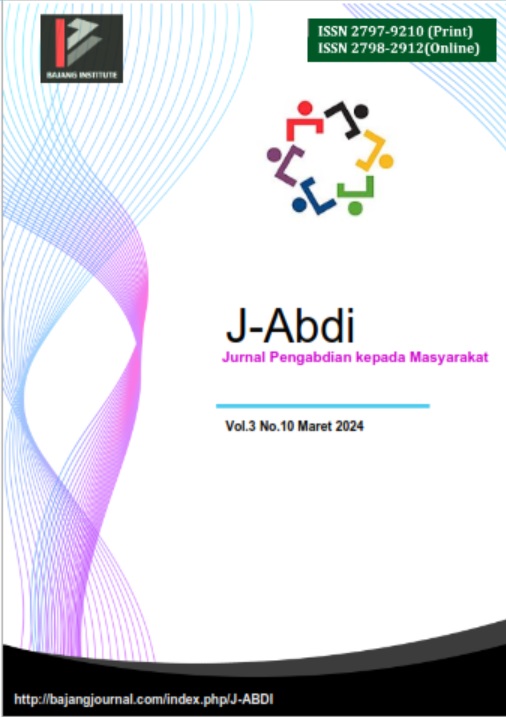PENDAMPINGAN PENYAMAAN PERSEPSI DESA WISATA PADA PENGELOLA DESA WISATA SANEO KABUPATEN DOMPU
DOI:
https://doi.org/10.53625/jabdi.v3i10.9184Keywords:
Institutional, Perception, Saneo VillageAbstract
The management of Saneo Tourism Village, perception alignment activities aim to create a harmonious understanding among the community, tourism village managers, and the local government. A participatory approach is used at every step of the process: identifying needs and potentials, conducting observations, holding focus group discussions (FGDs), and socializing. Evaluation methods are used to determine the effectiveness of the activities, ensure that perceptions are aligned, and create strategic follow-ups. As a result of the activities, participants gained a better understanding of the vision, mission, roles, and community-based management strategies. To achieve the village's vision as a sustainable community-based destination, capacity building for the community, environmental and cultural preservation, digital promotion, and the formulation of a joint action plan, the evaluation shows that the strategies used are very effective, and recommendations for enhancing cooperation and further training
References
Bramwell, B., & Lane, B. (2011). Critical research on the governance of tourism and sustainability. Journal of Sustainable Tourism, 19(4-5), 411-421.
Damanik, J. (2013). Pariwisata Berbasis Masyarakat: Teori dan Praktik. Yogyakarta: Pustaka Pelajar.
Michandani, E. S., & Arida, I. N. S. (2019). Perancangan Destination Branding Desa Wisata Kerta di Kecamatan Payangan Kabupaten Gianyar. Jurnal Destinasi Pariwisata, 7(1), 111. https://doi.org/10.24843/jdepar.2019.v07.i01.p17
Muarifuddin, M., et al. (2023). Pendampingan Badan Usaha Milik Desa Untuk Menciptakan Rintisan Desa Wisata Di Desa Timpik Kabupaten Semarang. EJOIN: Jurnal Pengabdian Masyarakat, 1(11), 1277–1286. https://doi.org/10.55681/ejoin.v1i11.1750
Suansri, P. (2003). Community-Based Tourism Handbook. Bangkok: Responsible Ecological Social Tour Project (REST).
Wibowo, R. (2021). Pengelolaan Desa Wisata Berbasis Masyarakat di Indonesia: Tantangan dan Strategi. Jakarta: PT RajaGrafindo Persada.
Murphy, P. E. (1985). Tourism: A Community Approach. New York: Methuen.
UNWTO. (2004). Tourism and Local Agenda 21: The Role of Local Authorities in Sustainable Tourism. Madrid: World Tourism Organization.
Cole, S. (2006). Cultural Tourism, Community Participation, and Empowerment. In Smith, M. K. & Robinson, M. (Eds.), Cultural Tourism in a Changing World. Clevedon: Channel View Publications.
Pretty, J. N., et al. (1995). Participatory Learning and Action: A Trainer’s Guide. London: IIED.
Hall, C. M., & Richards, G. (2000). Tourism and Sustainable Community Development. London: Routledge.
Mitchell, R. E., & Reid, D. G. (2001). Community Integration: Island Tourism in Peru. Annals of Tourism Research, 28(1), 113-139.
Timothy, D. J. (2007). Empowerment and Stakeholder Participation in Tourism Destination Communities. In Singh, S. et al. (Eds.), Tourism in Destination Communities. Oxfordshire: CABI.
Sharpley, R., & Telfer, D. J. (2002). Tourism and Development: Concepts and Issues. Clevedon: Channel View Publications.
Scheyvens, R. (1999). Ecotourism and the Empowerment of Local Communities. Tourism Management, 20(2), 245-249.
Gössling, S., Hall, C. M., & Weaver, D. (2009). Sustainable Tourism Futures. London: Routledge.
Ashley, C., & Roe, D. (1998). Enhancing Community Involvement in Wildlife Tourism: Issues and Challenges. London: IIED.
Tosun, C. (2006). Expected Nature of Community Participation in Tourism Development. Tourism Management, 27(3), 493-504.
Matarrita-Cascante, D., & Brennan, M. A. (2012). Conceptualizing Community Development in the Twenty-First Century. Community Development, 43(3), 293-305.
Hampton, M. P. (2005). Heritage, Local Communities, and Economic Development. Annals of Tourism Research, 32(3), 735-759.














